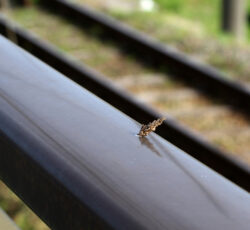How to Identify Bagworms
 How to Identify Bagworms
How to Identify Bagworms
Bagworms are common pests that have the potential to cause significant damage to trees, shrubs, and other plants. These insects are known for their distinctive protective bags that they construct from silk and bits of plant material they acquire from their feeding sites. In this blog post, we’ll discuss how to identify bagworms, the damage they can cause, and how to control them.
Identifying Bagworms
Bagworms are notorious for their distinctive bags, which are roughly the size and shape of a small pinecone. These bags are made from silk and bits of host plant material, making them incredibly hard to spot. To detect bagworms, you’ll need to look closely at the plant and the bag itself.
Bagworm larvae are small and pale, with a black head and a distinct yellow stripe running down the center of their bodies. They feed on the foliage of their host plants, cutting off twigs and leaves that they use to build their bags. As they grow, their bags become wider, and the larvae become more visible.
Female bagworms are flightless and remain in their bags throughout their adult life, laying their eggs inside the bag. Male bagworms are small, moth-like insects that emerge from the bags in late summer to search for females.
Damage Caused by Bagworms
Bagworms can cause significant damage to their host plants, especially if left untreated. They feed on the leaves of trees and shrubs, causing defoliation and weakening the plant overall. Over time, this damage can lead to the death of the plant.
In addition to the damage caused by feeding, the bags themselves can be unsightly and harmful to the plant. The weight of the bags can cause branches to bend and break, and the bags can trap moisture, causing rot and disease.
How to Control Bagworms
If you suspect that your plants are infested with bagworms, there are several steps you can take to control the infestation and prevent further damage.
1. Handpicking
One of the easiest ways to control bagworms is to handpick the bags off the plant. This method is most effective when the infestation is small or limited to a specific part of the plant. Be sure to dispose of the bags in a sealed container to prevent the larvae from re-infesting the plant.
2. Pruning
If the infestation is restricted to a specific part of the plant, pruning may be an effective solution. Prune the affected branches and dispose of them immediately to prevent the larvae from spreading.
3. Pesticides
Insecticides can be effective in controlling bagworms. Look for products that contain Bacillus thuringiensis (Bt), as it is a highly effective and safe insecticide. Apply the pesticide in the late spring or early summer when the larvae are active.
4. Natural Predators
Several natural predators, such as birds and parasitic wasps, can help control bagworm populations. Attracting these predators to your garden can be an effective way to control infestations naturally.
Preventing Bagworm Infestations
Prevention is the key to preventing bagworm infestations. Here are some proactive steps you can take to reduce the likelihood of an infestation:
1. Regular Inspections
Inspect your plants regularly for signs of bagworms. Look for the distinctive bags and larvae and take action quickly if you detect an infestation.
2. Maintaining Plant Health
Healthy plants are less susceptible to bagworm infestations. Ensure your plants are well-watered, fertilized, and pruned regularly to keep them healthy.
3. Proper Plant Placement
Avoid planting susceptible plants in areas that are prone to infestations. Placing your plants in well-draining soil and providing proper sunlight and irrigation can also help reduce the likelihood of an infestation.
4. Good Gardening Practices
Practicing good gardening habits can help reduce the likelihood of an infestation. Remove debris and dead foliage from your garden regularly, as it can provide an ideal habitat for bagworms.
Conclusion
Bagworms are a common garden pest that can cause significant damage to your plants. Understanding how to identify bagworms and control their infestation is crucial to maintaining healthy plants. By taking proactive steps to prevent infestations and using the appropriate control measures, you can keep bagworm populations under control and protect your plants from harm.
Think you may have a bagworm infestation? Let us help! Contact us today to learn more about what we can do for you!
